How to Feed & Maintain your Sourdough Starter
You’ve done it! You’ve created a living batter filled with wild yeast. Now let’s see how to feed & maintain your sourdough starter.
If you haven’t made your starter yet, visit this post to see how to make a sourdough starter from scratch.
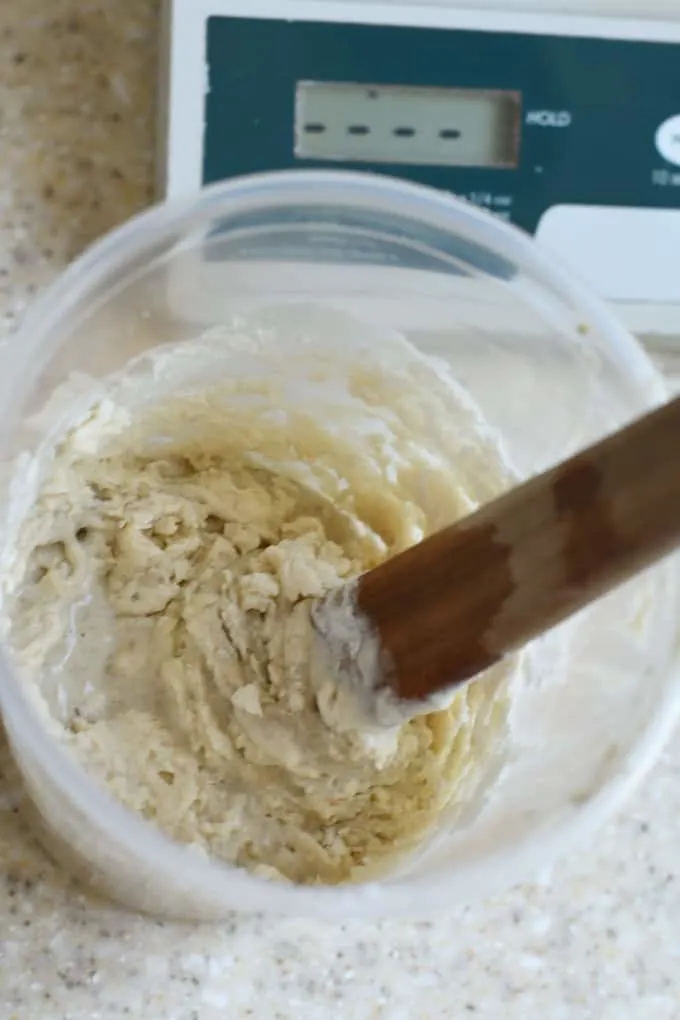
Right off the bat I’m going to say that there are a million ways to feed, maintain and use a sourdough starter. In fact, after you’re done reading this post, you should read through my instructions for How to keep a small sourdough starter to see of that method would work better for you.
I am going to outline for you how I maintain my sourdough starters. I tend to have a fairly relaxed attitude towards the process. It works for me and I think my approach can work for you if you don’t bake bread every single day (and even if you do).
At the end of the post you’ll find a how-to card that lists the ingredient amounts and steps to follow each time you feed your starter.
But first I’m going to give you all the how’s and why’s and try to answer any questions you might have.
Tips for using and maintaining your sourdough starter:
- Since I don’t bake every day, I keep my starters (yes, I have 3) in the refrigerator.
- If I’m making a 2-day recipe (most of mine are) I take the starter out of the refrigerator early in the morning of the day I’m making the dough. If the starter is inactive I feed it right away and it should be ready by early afternoon.
- If I’m making a 1-day recipe, I’ll take the starter out the night before and feed it if it’s inactive. It should be ready to use first thing in the morning.
- When the starter is cold from the refrigerator, I feed the starter using fairly warm water, warmer than body temp. The warm water will jump-start the cold starter.
- If the starter has been fed within the last 2-3 days, and has been refrigerated, you can probably go ahead and use it without feeding.
- If you’re not sure if the starter is active, drop a dollop into a bowl of water to see if it floats. If it does, it’s ready for baking.
- I write all my sourdough recipes to use 8 oz of active starter. After using 8 oz of starter in the recipe, I’m left with 4 oz of starter, exactly the right amount for feeding.
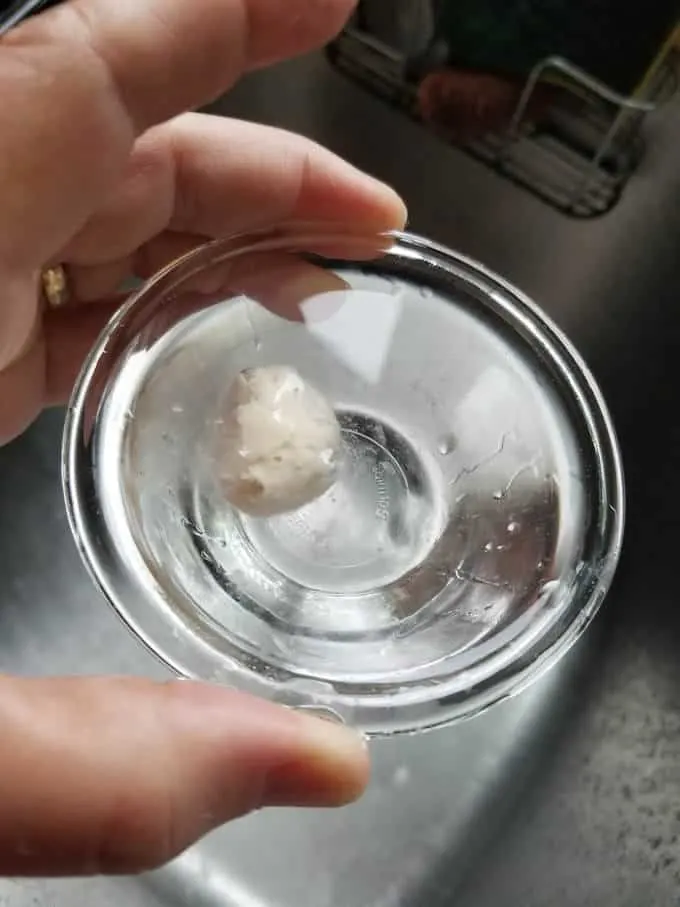
Schedule for feeding your sourdough starter:
- Your starter needs to be fed about 1x per week if refrigerated, and every day if left at room temperature.
- Generally, about 5-6 hours after feeding my starter is ready. The time may vary based on room temp, dough temp, etc. The starter should have doubled in volume and started to recede and/or pass the float test.
- I take my starter out of the refrigerator once a week for feeding, even if I’m not baking. Although, truth be told, I often go longer than a week between feedings and I haven’t killed it yet.
- Did you know you can dry your sourdough starter? Dried starter can be kept indefinitely.
- After you’ve removed the portion of starter for baking, feed the starter again and leave it at room temperature for 3-4 hours before putting it back in the refrigerator.
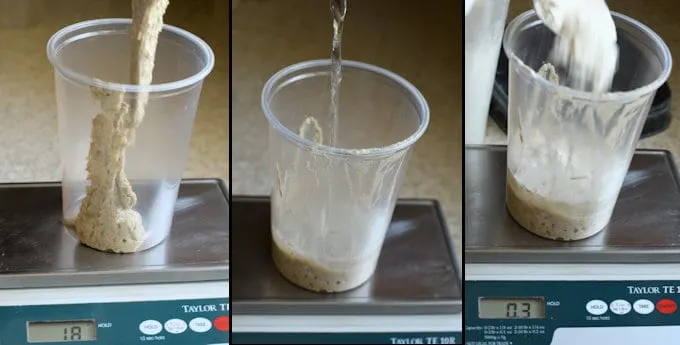
FAQs about feeding & maintaining Sourdough Starter:
Honestly, I’ve gone longer than a month without feeding my starter and I haven’t killed it yet. Give it a feeding and see if it wakes up. If it’s alive, keep feeding it until it is reliably doubling in size within 4-5 hours.
If you go more than about 2 weeks between feedings, you might want to give the starter 2-3 feedings before using. A starter that hasn’t been fed for weeks will be quite sluggish and your dough won’t be as lively.
If your starter was fed a day or two before, it’s possible to use the starter straight from the refrigerator. Give it a float test to make sure it’s active. The dough may take a little longer to ferment since the temperature of the dough will be colder.
It’s called “hooch” and don’t worry, your starter is still alive. Just stir that water back into the starter before feeding. Again, you might need 2 feedings to completely revive the starter since it’s been quite dormant.
To maintain your starter at 100% hydration it is best and most accurate to weigh your ingredients. If you’re just a little bit off every time you feed, eventually, your starter could be thrown out of balance.
No problem, use the amount of starter called for in the recipe. Then weigh out 4 oz of the remaining starter for feeding and discard the rest.
If you continually feed the starter without discarding, you’ll end up drowning in starter.
Yes, even if the discard is not active enough for baking bread, you can add it to many other recipes as a flavor and texture enhancer.
Unless you’re going away for an extended time, your starter should be just fine for a couple of weeks in the refrigerator. If you’ll be gone really long-term, put the starter into the freezer or dry it. Frozen or dried starter will need several feedings to rejuvenate.
If you appreciate this detailed information, I’d really appreciate a 5-star review.
How to Feed Sourdough Starter
Ingredients
- 4 oz unfed sourdough starter
- 4 oz all purpose flour
- 4 oz water (room temperature)
Instructions
- Weigh 4 oz of your unfed starter into a clean container. Discard the extra starter (see note)4 oz unfed sourdough starter
- Add the flour and water and mix until combined. Set aside at room temperature.4 oz all purpose flour, 4 oz water
- The starter is ready to use when it has doubled in volume and a small spoonful floats when dropped into a bowl of water. This generally takes 4-5 hours but the time can vary based on dough temperature and room temperature.
- If you do not plan to bake with the starter on the day it is fed, refrigerate 3-4 hours after feeding.
- Feed refrigerated starter weekly. If you go longer than a week without feeding, you may want to give the starter two feedings before using.
Would you like to save this recipe?
As an Amazon Associate and member of other affiliate programs, I earn from qualifying purchases.

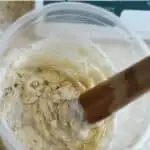





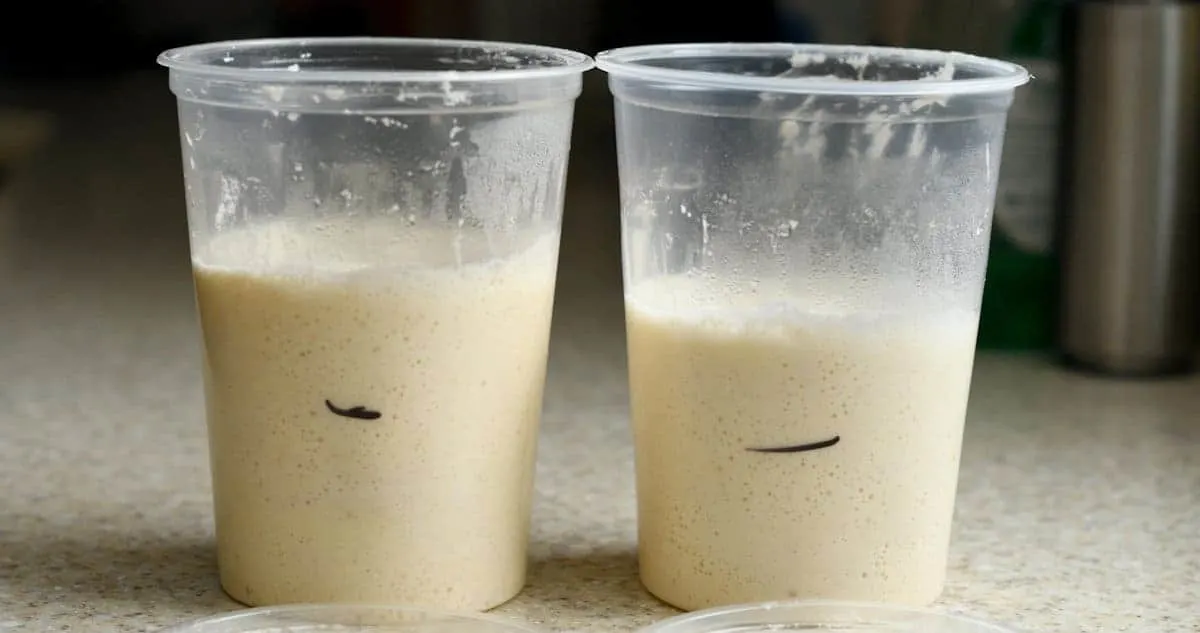
I am anxious to make your sourdough rye with caraway as soon as I can get out to buy the stone ground rye flour to add to the recipe. However, I would like to have a more sour taste to the rye than with the white bread. How do I do this. Can I add dill pickle juice to the recipe? Or is there a more favored method?
The amount of sour in a sourdough is about how to ferment the dough. A long cool rise encourages more acetic than lactic acid in the dough. Acetic acid is tangier. So instead of letting the dough rise overnight in the refrigerator, you can leave it for 2 days. Also, if you feed your starter less frequently leading up to making the bread the sour will be stronger. Don’t poor off the “hooch” (liquid) that forms on top of an unfed starter.
So I got a starter from a friend and I baked with it and then fed it…. I think I followed things right but after a few days in the fridge it is pretty solid looking. How long does it take until it develops that more liquid texture? have I screwed it up and can I fix it?
The texture will depend on how you feed. If you feed equal weights of starter-flour-water the texture will be similar to a very thick pancake batter. Mine often thins out after being the fridge for a week or so. If you are feeding with more flour the starter will be more solid. Whatever the texture, as long as it is rising and falling it is alive and can be used in your recipes.
I would love to get that recipe from you and give it a try, especially if it is as delicious as the white sandwich loaf! How do I get that recipe?
It’s linked where she wrote “Sourdough Rye Bread” 🙂
Dear Eileen
I am almost 80 and have been making bread and cooking for countless years for a family of 6(4 hungry children). Because of the lack of availability of bakers yeast, I’ve started experimenting with sourdough. I “stumbled” on your soft crust sourdough sandwich recipe and it is WONDERFULLY delicious and a godsend to me. With the arthritis in my hands, as slicing crusty bread is painful. My question is: Is there any room for substituting some of the white flour with rye flour?
Yes, you could use about 1/3 rye and 2/3 white. Of course it will change the texture of the bread. I also have a nice Sourdough Rye Bread recipe that is a personal favorite of mine.
Hi Eileen,
I have tried to start my sourdough 3 times now. Again it is runny and I really never see it rise. In the mornings it has a soft pink colored liquid on top which I just stir back into the batter. I am using one cup water to one cup of flour when feeding it of which the recipe called for. I have seen 4oz in some of your comments so I have a couple of questions,
1) Can I use a glass bowl to make my started in or should I be using a glass jar.?
2) Do I remove and add 4 or 8 oz when feeding
3) Is my starter ok even though runny and has the pinkish fluid on top?
Today is day 6 so I am going to feed every 12 hours but not sure if I remove .4 or 8 oz each time.
I look forward to hearing from you!!
Cheryl
Hi Cheryl, If you see pink or orange streaks in the starter you should discard it and start over. Pink or orange streaks indicate bad bacteria has grown in the starter. Same if you see any type of mold at all. If the liquid is clear or even a darkish gray that just the “hooch” and it ok. But definitely there shouldn’t be any pink or orange at all. Answers to your questions:
1) You can use any type of container as long as you cover it. Plastic wrap or foil is fine. You don’t want to surface to dry out.
2) The amount you discard when feeding depends on your own schedule. I have two methods; the full starter method is always kept at 12 oz. and is always fed with equal weights of starter-flour-water. This is the method described here in this post. I also keep a small starter which is maintained at 3 oz and fed 2x before using.
3) No, If it is really pink then it should be discarded. Grayish liquid just means the starter is hungry, but any pink, orange or mold is bad.